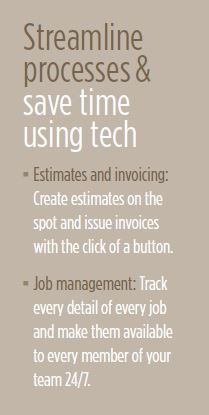Going Digital: what it takes to make it work
 From accounting and scheduling to communicating with customers and keeping crews on track, digital technology has the potential to improve and streamline virtually every aspect of any business.
From accounting and scheduling to communicating with customers and keeping crews on track, digital technology has the potential to improve and streamline virtually every aspect of any business.
However, according to Tom Droste, CEO of Logical Engine, only about 25% of the paint companies he deals with have a substantial amount of automation.
“Even the smallest amount of automation can be a real game changer for a business,” says Droste. “The right system can save you time and money; improve your overall organization; and make the work experience better for everyone.”
IMPLEMENTATION IS KEY
According to Droste, the biggest hurdle a business owner has to clear to begin going digital is inertia.
“People don’t like change,” he says. “And sometimes the people who work for those people like it even less. But, if you’re going to grow your business, you’re going to have to change. The key is to do it in a manner that’s positive and encourages buy-in from team members.”
David Chism of marketing management company A David Creation agrees. A key part of Chism’s business is helping small contractors make smart tech decisions and assisting with the execution of those plans.
“By virtue of spending more time on computers and systems, office staff tend to be a bit more tech savvy than paint guys,” says Chism. He recommends first letting a few of the office staff try out the system before introducing it to crews.
He advises, “Give them 60 to 90 days to try it out and make sure you keep checking in and reminding them how this change is going to improve systems and make their jobs easier.”
ATTITUDE IS EVERYTHING
Chism advises business owners to avoid soft phrasing when it comes to change. “Saying ‘we’re thinking about a change’ is just asking for trouble,” he says. “It’s better to communicate that you’re making the change, here’s why, and here’s when.”
He adds, “You want to set a hard and fast implementation date, share it, and note that all other systems will be shut off at that time.” He also suggests you enlist the internal folks who participated in the 60- to 90-day trial period to seek out the tech-savvy guys in the field and help spread the word.
“It’s usually pretty easy to spot the guys who like technology,” he says, “They’re the ones who use their phones for everything and have the coolest apps. Find those guys and make sure they understand how to use the system, then encourage them to show others why it’s worth their time to get on board.”
PLAN FOR SUCCESS
Asked what mistakes he sees companies make when implementing technology, Droste stated that a failure to allocate enough time for implementation is common. “You have to realize that learning how to integrate a new system is going to take more time than the normal workday. You have to plan for that. If all goes well, you’ll make up that time—and then some—very shortly.”
Chism cites ‘biting off more than you can chew’ as a common mistake he sees.
“Baby steps is a fine approach,” he says. “Just because you bought the whole package doesn’t mean you have to implement it all at once. Take on what’s needed—no matter how mundane—find some success, share that success, and keep moving forward.”
GET THE SUPPORT YOU NEED
Chism notes that when choosing a system or software, support should be near the top of your list of must-haves.
“Different companies offer different types of support,” he says. “Some offer instant chat support, others get you answers in a few hours. Make sure you know what you’re getting and for how long. And by all means, use it.”




